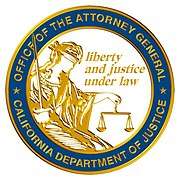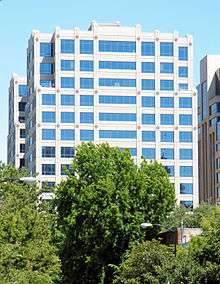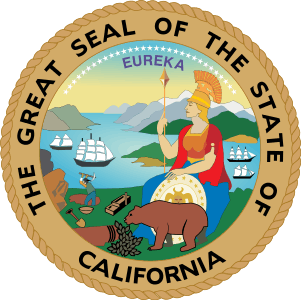Attorney General of California
| Attorney General of California | |
|---|---|
 Seal of the Attorney General of California | |
| Department of Justice | |
| Style | The Honorable |
| Term length | Four years, two term limit |
| Inaugural holder |
Edward J. C. Kewen 1849 |
| Formation | California Constitution |
| Salary | $151,127 |
| Website |
oag |
The Attorney General of California is the state attorney general of the Government of California. The officer's duty is to ensure that "the laws of the state are uniformly and adequately enforced" (Constitution of California, Article V, Section 13.) The Attorney General carries out the responsibilities of the office through the California Department of Justice. The Department employs over 1,100 attorneys (meaning that the AG supervises the governmental equivalent of a law firm much larger than the vast majority of U.S. private law firms) and 3,700 non-attorney employees.
The California Attorney General is elected to a four-year term, with a maximum of two terms. The election is held at the same statewide election as the Governor, Lieutenant Governor, Controller, Secretary of State, Treasurer, Superintendent of Public Instruction, and Insurance Commissioner.
Duties

According to the state Constitution and the California Government Code, the Attorney General:
- As the state’s chief law officer, ensures that the laws of the state are uniformly and adequately enforced.[1]
- Heads the Department of Justice, which is responsible for providing state legal services and support for local law enforcement.[2]
- Acts as the chief counsel in state litigation.
- Oversees law enforcement agencies, including District Attorneys and Sheriffs.[1]
History
Although the office of Attorney General dates to the admission of California to the Union, the office in its modern form dates to Proposition 4 of 1934,[3] sponsored by Alameda County District Attorney Earl Warren as one of four initiatives he sponsored to substantially reform law enforcement and the judiciary. Previously, the attorney general lacked jurisdiction over matters in the jurisdiction of locally elected district attorneys and sheriffs.[4] Warren went on to become Attorney General himself in 1938 where he reorganized state's law enforcement into districts.
Notable attorneys general from California
For a comprehensive list, see List of Attorneys General of California.
- Jerry Brown – 2007–2011, Governor of California (1975–1983; 2011–present), Mayor of Oakland (1999–2007); Presidential candidate (1976; 1992).
- George Deukmejian – 1979–1983, Governor of California (1983–91)
- Stanley Mosk – 1959–1964, Associate Justice of the California Supreme Court (1964–2001)
- Pat Brown – 1951–1959, Governor of California (1959–1967)
- Earl Warren – 1939–1943, Chief Justice of the United States (1953–1969); Governor of California (1943–1953); District Attorney of Alameda County (1925–1939)
- Ulysses S. Webb – 1902–1939, longest serving at 37 years
- Recent
- Xavier Becerra – 2017–present, U.S. Representative (1993–2017)
- Kamala Harris – 2011–2017, U.S. Senator (2017–present); District Attorney of San Francisco (2004–2011)
- Dan Lungren – 1991–1999, U.S. Representative (1979–89; 2005–13)
References
- 1 2 California Constitution, Article V, Section 13 Archived January 8, 2011, at the Wayback Machine.
- ↑ California Government Code §15000
- ↑ "History of Initiative and Referendum in California". Retrieved 10 September 2018.
- ↑ "Proposition 4 (1934)".
External links
- Official website

- California Attorney General articles at Legal Newsline Legal Journal
- California Attorney General articles at ABA Journal
- News and Commentary at FindLaw
.jpg)
